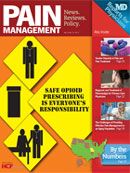Elevating Pain Management: First and Next Steps in Pain Safety
Fast, good, and cheap: the rule is we only get two in life -- yet in today's health care system, clinicians are pressured to achieve all three. However, the necessary steps for ensuring safe and good pain management are a challenge for physicians who practice in the world of the 15-minute office visit
Fast, good, and cheap: the rule is we only get two in life -- yet in today’s health care system, clinicians are pressured to achieve all three. However, the necessary steps for ensuring safe and good pain management are a challenge for physicians who practice in the world of the 15-minute office visit.
Many primary care physicians facing pressure to see the maximum number of patients each day may think they do not have enough time with patients seeking treatment for chronic pain to implement all of the recommended monitoring and safety procedures. But don’t try telling that to Bruce Nicholson, MD, director of Pain Specialists of the Greater Lehigh Valley, PA. “Primary care is about monitoring labs all day long and having good systems in place. The idea that a clinician finds the procedures for monitoring pain patients too onerous, I don’t buy that,” he says.
Nicholson directs six other physicians in a multi-site private practice that serves 26,000 patients annually. Every patient who is treated with opioid medications for pain receives a random urine drug test. “Although it’s not every single patient, every time they come in,” every patient gets one at some point, Nicholson says. Each patient must also sign an opioid agreement that is reviewed yearly. Patients’ responsibilities for the safe and proper use and storage of opioids are discussed during every visit. Nicholson says that relying on staff and systems is essential to practicing safe and effective pain management.
“Staff is vitally important. You can’t be a clinician doing it all by your self,” says Nicholson. At his clinics, the staff monitors the implementation of urine drug testing and prescription refill requests and red-flag patients when there are concerns of aberrant behaviors.
Nicholson recommends that physicians who are starting at “ground zero” for opioid pain safety review several opioid prescribing agreements and patient informed consent consent forms and choose one for their practice. He also recommends that they review and understand the principles of opioid prescribing and monitoring patients from Gourlay and Heit’s universal precautions (http:// onlinelibrary.wiley.com/doi/10.1111/j.1526-4637.2005.05031.x/abstract).
Lynn Webster, MD, says that clinicians can start by prospectively assessing patient risk using tools such as the Opioid Risk Tool (http://www.painknowledge.org/physiciantools/ORT/ORT%20Patient%20 Form.pdf) or the Screener and Opioid Assessment for Patients with Pain (SOAPP; http://www.painedu. org/soapp.asp). “You must also ask patients whether they or anyone in their family has a history of substance abuse,” says Webster.
Nicholson says that even small changes can make the difference. “Just implementing two things: good opioid prescribing principles and monitoring of patients will advance how we manage pain patients.” Webster wants clinicians who are already using routine risk assessment and opioid treatment agreements to “do a better job of assessing mental health and stress.” Mental health disorders such Post-Traumatic Stress Disorder, bipolar disorder, and ADHD (seen consistently across military and civilian settings) predispose patients to over-using opioids and accidental death.
In a similar vein, Nicholson wants to see pain-savvy clinicians develop a better understanding of how to manage risk in patients, including “understanding how to exit opioid therapy, how to manage problematic issues and act on them.” Many patients are referred to Nicholson’s practice with abnormal urine drug screens or prescription issues. Rather than just “letting it go this time,” physicians need to “address these challenges and learn how to manage these patients.”
Nicholson uses a straightforward, non-confrontational approach when dealing with patients who may be abusing, misusing, or diverting their pain medications. He says he’ll tell them, “I didn’t find drug in the urine that you’re been prescribed,” and work with them to address the reasons why. He recommends using smaller pill loads or psychotherapy first to address problematic behaviors. In Nicholson’s practice, patients get fired only if they threaten the staff or if they break the law. “I cringe when I hear doctors talk about firing patients. Firing a patient doesn’t achieve anything. It forces patients into an antagonistic position with the medical community,” he says.
Nicholson tells patients who need to be “exited” from opioid therapy that “We don’t consider you to be a good candidate for opioid therapy. We’ve given you ample opportunities and you don’t respond appropriately to these medications. Therefore we’re going to take you off opioids and talk about other options.” When Nicholson speaks to other physicians about safe and effective pain management, he always shares this caveat: Every patient has a right to a trial of opioids if they have significant pain. But they have to earn the privilege of remaining on opioid therapy.”
